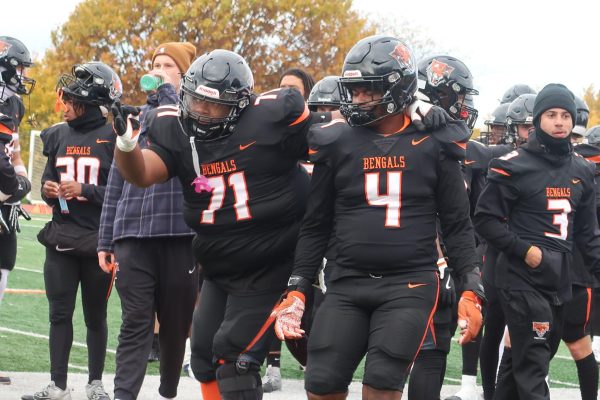Juggling act
The life of a D-III student-athlete isn’t all fun and games.

Softball player Kate Brownell juggles academics and athletics at Buffalo State.
After taking 18 credits last year, working part-time, commuting 50 minutes (each way), and playing softball here at Buffalo State, I know what it’s like to be in a juggling act. Last year, on April 9, I realized just how hectic a student-athlete’s life could be.
Waking up at 4:30 a.m. to get ready for the long day ahead seemed to be the norm for me last semester since I had an 8 a.m. class every day, but it didn’t seem to bother me because it was softball season and my team usually had games.
The weather was bitter and rainy that Tuesday when we had a doubleheader against the University of Rochester. By the time the second game rolled around, the temperature was dropping and the sun was setting.
It was the bottom of the seventh inning. I was 2 for 4 on the day already and the game was tied.
There was a runner on second when I came up to the plate, and I remember letting the first strike go by. I stood up there ready to win the battle. And I did by ripping the ball through the left side of the field for a walk-off single.
I was so excited that we came back from a 6-0 deficit after the first two innings. But after the game ended around 8 p.m., I realized I had a long 50-minute drive back home and a project to finish.
I ended up staying up until 1 a.m. just to finish my project and had to be up in about three and a half hours to do it all over again. As a student-athlete, sleep is tough to come by while trying to balance academics, work, and a sport.
For student-athletes, budgeting time can be a struggle — a constant toss-up of maintaining high academics, excelling in a sport, working to pay bills, keeping a social life, and managing unpredictable but always-present obstacles.
Ever since I was able to play sports, I did just that. As it was with many athletes, it was my escape from the outside world. The world we escape to can be found on the soccer field, the basketball court, the ice, or in the pool.
But I found it on the softball diamond.
Student-athletes certainly don’t have the glamorous life many believe they do. If anything, their college experience is more stressful and exhausting than the average college student. Although people might believe that student athletes receive the “royal treatment” on campus, it couldn’t be any further from the truth.
During the season, you may find that athletes are absent from classes due to their hectic game schedules. Students might see this as “getting off the hook,” but in reality, it only makes it more difficult for us trying to make up all the missed work while staying on track with the work that’s at hand.
My team competes in 40 games in one month. How do we fit all those games in such a short period of time, you might ask?
Every day we play, it’s a doubleheader, playing back-to-back games against the same team.
There are weeks we play four different teams in the same week. That’s eight games on top of practicing on days we don’t have games, all while still trying to manage schoolwork that we’ve missed.
Many students believe that athletes are only in college to pursue their athletic career so they don’t focus on their grades. That too is a misconception.
If anything, student-athletes are more motivated to keep their grades up, striving to excel in school as well as on the field. An athlete is not eligible to play unless their GPA is above a 2.0.
And in some cases, coaches will set a desired GPA for the team as a whole, holding higher standards for their players than most. If the goal is not reached, there are consequences that follow.
Some coaches may enforce mandatory study hall hours due to low grades.
It’s not uncommon for students to look at athletes on campus and automatically assume they have special privileges. They believe that athletes receive more extensions on assignments, are allowed to skip classes, and are set for their future.
If athletes are caught skipping classes (unless they’re excused), there are also penalties that follow. A coach may require 6 a.m. conditioning for the individual on the first offense. If the athlete is caught again, the entire team may be required to attend 6 a.m. conditioning and if the athlete is caught for a third time, the player may be asked not to come back to the team.
Not only are there rules given in the student handbook, but each year, student-athletes have rules to follow from the NCAA and their own coaching staff. Being on an athletic team requires a great deal of commitment.
Studies have frequently shown the positive effects playing sports have on academic achievement. High school students who play a sport are 48 percent less likely to drop out of school.
Recent reports from the NCAA show that of the 435 Division III schools, student-athletes graduated at higher rate compared to the rest of the student body. Also, Division III athletes show a higher graduation rate than their counterparts in Division I and II.
Research has also shown that being involved in sports can affect the brain’s physiology by increasing cerebral capillary growth, blood flow, oxygenation, brain tissue volume, and neurotransmitter levels. These changes in the brain are associated with improved attention, information processing, and improved information storage.
Any sport at the collegiate level is just as demanding as the next. Student-athletes that play Division III sports are here because they have a passion for the game they grew up playing.
We love what we do. We don’t have the luxury that Divisions I and II have of being recruited with a scholarship. We willingly give up our own time to be successful in something we love.
There is no offseason when it comes to being a student-athlete. Softball is a spring sport but that doesn’t mean we take the fall and winter off.
The NCAA allows us five weeks of practice in the fall and one tournament. The remainder of the time between then and preseason is up to each individual to put in their own hours.
The tedious workouts and countless hours put into the “offseason” benefits us for the regular season. Lifting three days a week right now on top of speed school two days a week, a new program built into the athletic program, and any extra work we put in outside of that is a juggling act by itself.
Participating on a team helps create friendships when you find that common thread between two or more people. Everyone is playing under the same set of rules and striving for a common goal. In order to achieve that goal, you must learn to trust each other, knowing that if you mess up, the person next to you will pick you up.
There are many unwritten skills and values sports teach athletes. A sport instills the importance of hard work, teamwork, persistence, determination, and cooperation. Research proves that children who play sports tend to have higher self-confidence and self-worth.
From the classroom to the field, student-athletes are held accountable for their every move. They’re not only representing themselves, but Buffalo State as well.
The demanding schedule they take on doesn’t help them receive special treatment from the faculty or students on campus. The student-athletes here on campus do what they do strictly for the love of the game.
Even though the college experience may seem stressful for student-athletes, it is worth it in the end. Most athletes’ sports careers come to a conclusion after college. These are the years you’ll never get back so you have to make every second count. Even if that does mean hectic days and sleepless nights to maintain a successful career.
Email: brownell.record@live.com



